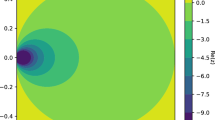Abstract
BDF formulas are among the most efficient methods for numerical integration, in particular of stiff equations (see e.g. Gear in Numerical initial value problems in ordinary differential equations, Prentice Hall, Upper Saddle River, 1971). Their excellent stability properties are known for precisely half a century, from the first calculation of their angles of \(A(\alpha )\)-stability by Nørsett (BIT, 9:259–263, 1969). Later, more insight was gained and more precise values were calculated numerically (see for example Hairer and Wanner in Solving ordinary differential equations, Springer, New York, 1996, Sect. V.2). This was the state-of-the-art, when Akrivis and Katsoprinakis (BIT, 2019. https://doi.org/10.1007/s10543-019-00768-1) discovered exact values for these angles. In this note we simplify the derivation and results by using Maple.
Similar content being viewed by others
Avoid common mistakes on your manuscript.
Let \(z=x+iy=e^{i\varphi }\) lie on the unit circle, then the root locus curve for k-step BDF is
(see e.g., [3, Sect. V.1, Eq. (1.17)]). It describes the boundary of the stability domain (see Fig. 1).
We use the classical parametrization of the unit circle
(see e.g., Euler’s Calculus Integralis, Caput V, § 261, 1768). The angle \(\alpha \) of \(A(\alpha )\)-stability is then computed by the following Maple commands:

Here, \(p=\tan \alpha =-\frac{v}{u}\), and pdn is the numerator of \(\frac{dp}{dt}\), a polynomial in \(t^2\) due to symmetry, whose largest root \(t_0^2\) we have to compute (corresponding to the extremal value \(w_0\) furthest away from the origin). For \(k=3,4\) and 6, this \(t_0^2\) is rational, which leads to expressions for \(p_0=\tan \alpha \) containing only one square root (with Digits:=30):
k | \(t_0^2\) | \(p_0=\tan \alpha \) | \(\alpha \) |
|---|---|---|---|
3 | \(\frac{9}{35}\) | \(\frac{329}{135}\sqrt{35}\) | \(86.032366860211647332387423479^{\circ }\) |
4 | \(\frac{2}{3}\) | \(\frac{699}{512}\sqrt{6}\) | \(73.351670474578482110409536864^{\circ }\) |
5 | \(\times \) | \(\times \) | \(51.839755836049910391602721533^{\circ }\) |
6 | \(\frac{15}{13}\) | \(\frac{45503}{1974375}\sqrt{195}\) | \(17.839777792245700101632480553^{\circ }\) |
The case \(k=5\) is more complicated, since hereFootnote 1
Therefore we have to simplify the expression for \(p_0\) by using the field structure of the set \(\{ a+b\sqrt{2033}~;~ a,b \hbox { rationals}\}\). The command evala(simplify(p0)) in Maple leads to
By differentiating x (instead of p), we obtain exact values for the values of D in Gear’s definition of stiff stability (see [2] or [3, p. 250]) as
k | 3 | 4 | 5 | 6 |
|---|---|---|---|---|
D | \(\displaystyle \frac{1}{12}\) | \(\displaystyle \frac{2}{3}\) | \(\displaystyle \frac{93}{80}+\frac{25}{48}\sqrt{5}\) | \(\displaystyle \frac{243}{40}\) |
Notes
The factor \((t^2+1)^4\) is related to the order of the method; a similar factor appears for all k and is the deeper reason why the computation of \(t_0\) is so easy.
References
Akrivis, G., Katsoprinakis, E.: Maximum angles of \(A(\vartheta )\)-stability of backward difference formulae. BIT (2019). https://doi.org/10.1007/s10543-019-00768-1
Gear, C.W.: Numerical Initial Value Problems in Ordinary Differential Equations. Prentice Hall, Upper Saddle River (1971)
Hairer, E., Wanner, G.: Solving Ordinary Differential Equations, vol. II, 2nd edn. Springer, New York (1996)
Nørsett, S.P.: A criterion for \(A(\alpha )\)-stability of linear multistep methods. BIT 9, 259–263 (1969)
Author information
Authors and Affiliations
Corresponding author
Additional information
Communicated by Christian Lubich.
(Dedicated to the 75th anniversary of Syvert P. Nørsett.)
Publisher's Note
Springer Nature remains neutral with regard to jurisdictional claims in published maps and institutional affiliations.
Rights and permissions
About this article
Cite this article
Gander, M.J., Wanner, G. Exact BDF stability angles with maple. Bit Numer Math 60, 615–617 (2020). https://doi.org/10.1007/s10543-019-00796-x
Received:
Accepted:
Published:
Issue Date:
DOI: https://doi.org/10.1007/s10543-019-00796-x





